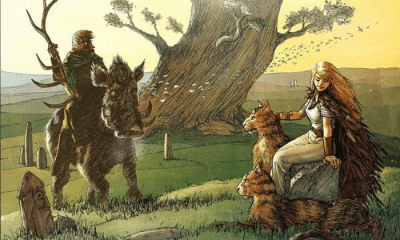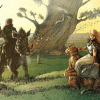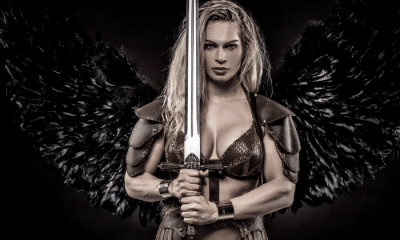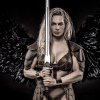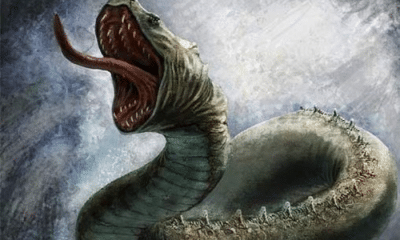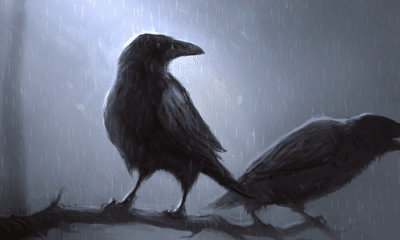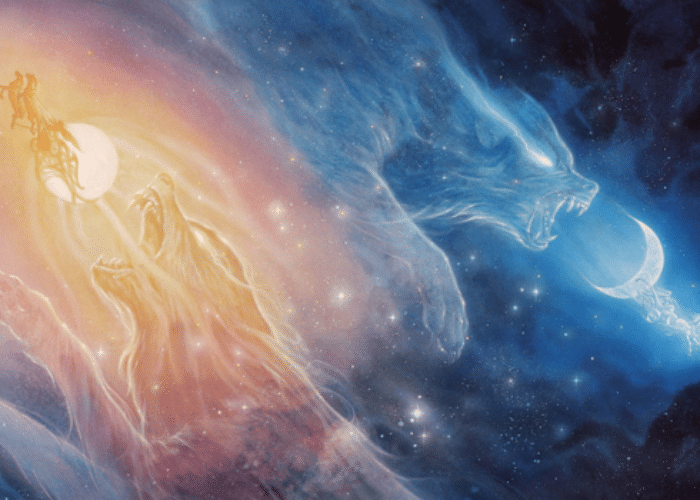
Norse
Who Were Sól and Máni in Norse Mythology?
Who Were Sól and Máni in Norse Mythology?
In Norse mythology, Sól and Máni were the goddess and god of the sun and moon.
Unlike other gods of the sky, however, their trip across the sky was an attempt to escape a pair of hungry monsters!
According to the Norse people, each day the goddess Sól drove the chariot of the sun across the sky. At night, her brother Máni took the same trip with the moon.
Sól and Máni did not travel alone, however. Sól was chased by a ravenous wolf named Hati while Máni fled from Hati’s sister, Sköll.
At Ragnarök, both Sól and Máni would lose their long-lasting race across the sky. They would be caught by the pursuing wolves and devoured.
While their fate at Ragnarök is a familiar trope of Norse mythology, most other aspects of Sól and Máni show that they are not uniquely Germanic characters. They fit into widespread archetypes of solar and lunar deities.
Sól and Máni’s Harrowing Trip Across the Sky
In Norse mythology, Sól and Máni were the deities of the sun and the moon.
They were brother and sister, the children of a god called Mundilfari. Sól personified the sun while her brother Máni was the god of the moon.
Each of them drew a chariot across the sky with the light of their domain. They did not travel alone, however.
Sól and Máni were each chased by an enormous wolf. Children of Fenrir, the monstrous son of Loki, these wolves tried each day and night to devour Sól and Máni.
Sól was chased by the male wolf, Hati. His sister Sköll chased after Máni and the moon. Both drove their chariots toward the horizon as quickly as they could to escape the ravenous wolves.
According to some versions of their story, Sól and Máni were born specifically to give light to the world and allow men to mark the passage of time. When the world began, they did not know where to travel so Odin had to show them the proper path to take across the sky.
In another story, however, Sól and Máni were born as mortals.
Their father, Mundilfari, was so pleased with his children’s beauty that he named them after the sun and moon. The gods were angered by this perceived arrogance, however, and punished the family.
They put the children in the sky to guide the real sun and moon on their paths. Mundilfari lost his children and Sól and Máni were put in a position of endless toil and danger.
Each day they raced Hati and Sköll across the sky. Like the other gods, however, they knew they were eventually fated to lose this contest.
At Ragnarök, the wolves would finally catch their prey. Before the last battle began, Sköll and Hati would catch up to Sól and Máni to swallow them whole.
The world would be plunged into total darkness. The wolves, according to some sources, would finally leave the sky and come to Midgard to eat the dead who littered the landscape.
According to the Prose Edda, however, light would not be lost forever.
Just before her capture but Hati, Sól would give birth to a daughter. She would be as lovely as her mother and would survive the battle of Ragnarök.
The surviving gods would return to Asgard to rebuilt, new land would emerge, and one surviving human couple would climb out of the branches of Yggdrasil. When they did, Sól’s daughter would take her mother’s place in the sky to give light to a new world.
My Modern Interpretation
Of all the gods in Norse mythology, Sól and Máni are perhaps most identifiable as belonging to a broader Indo-European archetype.
Most ancient cultures assigned a pair of deities to represent the sun and moon. Sól and Máni, however, are shown in a manner that is widespread across Europe.
They are so closely linked to other European gods and goddesses, in fact, that their story is sometimes mistaken to be a later edition that was inspired by other cultures.
In the first part of the archetype, both Sól and Máni are named for what they represent. Their names literally translate as “Sun” and “Moon.”
This has occasionally led to some confusion between Norse and Roman mythology. The Latin word for the sun is “sol” and their god, too, was named for it.
While some later myths were most likely influenced by Roman sources, the similarities between the Norse Sól and the Roman Sol are due to a distant linguistic link rather than direct borrowing.
In fact, outside of Scandinavia Sól’s name was changed to reflect the local language. In Germany she was known as Sunni, a name that came down into English as the word “sun.”
The similarities are seen not only in the way they were named, however.
A common aspect of Indo-European and Semitic gods is that they use some type of vehicle to move the sun and moon across the sky.
This can be seen as early as ancient Egyptian mythology, in which the sun god Ra was often shown on a boat. Sól and Máni drive chariots just as the Greek Helios and Selene did.
The fact that this archetype developed early in Germanic religion can be seen in the archaeological record. A gilded bronze statue discovered in Zealand dates to roughly 1400 BC and shows the familiar image of the sun disk on a horse-drawn chariot.
Many Indo-European sun and moon gods are, like Sól and Máni, also siblings. Typically they are also of opposite genders as well.
This is the case for the Greek Apollo and Artemis, who adopted many of the attributes of the sun and moon gods from the Titans Helios and Selene.
The one major difference between Sól and Máni and other examples in Indo-European solar and lunar deities is in their genders.
Typically, Indo-European cultures depicted the sun as masculine and the moon as its feminine counterpart. While other civilizations showed some variation in this, throughout Europe and India it is virtually universal.
The Norse, however, inverted these gender roles. Sól was the sun goddess while Máni was a male deity of the moon.
Linguists, however, have been able to provide a simple solution for this unique depiction.
Sól and Máni’s characterizations correspond to their gender in the Germanic languages. While the Latin word sol, for example, is a masculine noun, in Norse sól is feminine.
The inverted genders of the deities were thus probably imagined to make the personifications match the language.
Sól and Máni fit neatly into this archetype despite the fact that other Norse gods differ more greatly from such archetypes. The Norse, for example, did not typically see their gods as personifications in the manner of Sól and Máni.
This indicates that the solar and lunar deities were among the first to be worshipped by the Germanic people and remained relatively unchanged over time. Even thousands of years after other Indo-European solar and lunar deities were differentiated, Sól and Máni still fit closely into one of religion’s most ancient archetypes.
In Summary
Sól was the Norse goddess of the sun. Her brother Máni was the god of the moon.
Each drove a chariot across the sky. They were pursued by a pair of wolves, also brother and sister, who would eventually destroy them at Ragnarök.
According to one later story, however, all light would not entirely disappear after Sól and Máni were killed. Sól’s daughter would take her place as the sun goddess when the world was reborn.
While the story of Ragnarök is distinctly Norse, other aspects of Sól and Máni’s characters show them to be part of a more widespread archetype.
It is common for the sun and moon to be personified as a pair of deities, often male and female, in Indo-European religions. These gods and goddesses typically drove across the sky in some type of vehicle, often the same types of chariots Sól and Máni drove.
These deities were also usually named as the sun and moon in their own languages rather than given individual names. For Sól and Máni, this is likely the reason their genders are the opposite of other deities in this tradition.
Sól and Máni fit so strongly into this Indo-European archetype that it is likely that they were among the first Germanic gods and almost certainly the most unchanged over time.


